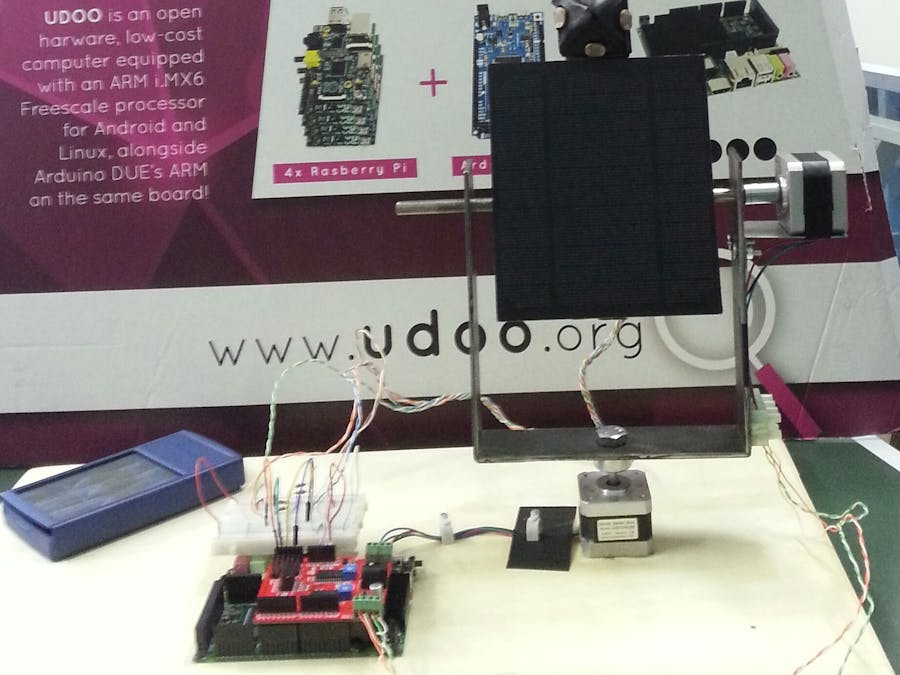#include <Stepper.h>
#include <limits.h>
#define fotoresistenza4 A9
#define fotoresistenza3 A8
#define fotoresistenza2 A5
#define fotoresistenza1 A4
#define dolong(x) ((x)>=0?(long)((x)+0.5):(long)((x)-0.5))
#define dolongint(x) (int)dolong(x)
int PinDirezione_1 = 3;
int PinStepper_1 = 2; //definisce stepper 1 e 2
int PinDirezione_2 = 7;
int PinStepper_2 = 6;
int _step = 0; // valore iniziale per le funzioni che guidano motori passo-passo
int counter_steps_1 = 0;
int counter_steps_2 = 0;
float LR;
float UD;
float km1 = 0.65;
float km2 = 0.45;
int SUM;
int AV;
int FP1;
int FP2;
int FP3;
int FP4;
signed counter_diff_passi;
int num_steps_1 ;
int num_steps_2 ; //per efettuare una rivoluzione, num_ steps = 1600
boolean dirOrario = true; //rotazione verso dx
boolean dirAntiOrario = false; // rotazione verso sx
void setup()
{
Serial.begin(9600); //Comunicazione seriale al computer
pinMode(A4,INPUT);
pinMode(A5,INPUT);
pinMode(A8,INPUT);
pinMode(A9,INPUT);
pinMode(PinDirezione_1, OUTPUT); //definisce la firezioen nella quale lo stepper 1 ruota
pinMode(PinStepper_1, OUTPUT);
pinMode(PinDirezione_2, OUTPUT); //definisce la direzione nella quale lo stepper 2 ruota
pinMode(PinStepper_2, OUTPUT);
}
float diff_1(int FP1, int FP2) {
float res1;
res1 = FP1 - FP2;
return res1;
}
int sum(int FP1, int FP2, int FP3, int FP4) {
int res3;
res3 = FP1 + FP2 + FP3 + FP4;
return res3;
}
int avarage(int SUM) {
int res4;
res4 = SUM/4;
return res4;
}
//queste due funzioni(diff_1 e diff_2) calcolano la differenza
//tra le intensit delle luci sull'asse orizontale
//e su quello verticale dei due fotoresistori
float diff_2(int FP3, int FP4) {
float res2;
res2 = FP3 + 100 - FP4;
return res2;
}
int steps (float X, float k) {
int passi;
if( X < 0.0){
passi = dolongint ( - k * X);
}else{
passi = dolongint ( k * X);
}
return passi;
}
//
// int steps_1(float X) {
// int passi_1;
// if( X < 0.0){
// passi_1 = dolongint ( -km1 * X);
// }else{
// passi_1 = dolongint (km1 * X);
// }
// return passi_1;
// }
//
//
// int steps_2(float Y ) {
// int passi_2;
// if(Y < 0.0){
// passi_2 = dolongint ( -km2 * Y);
// }else{
// passi_2 = dolongint ( km2 * Y);
// }
// return passi_2;
// }
//
void loop()
{
/*digitalWrite(PinStepper_1, LOW);
digitalWrite(PinStepper_2, LOW);*/
int FP1 = (analogRead(fotoresistenza1));
int FP2 = (analogRead(fotoresistenza2));
int FP3 = (analogRead(fotoresistenza3));
int FP4 = (analogRead(fotoresistenza4));
Serial.print ("Valore luminosit_0=");
Serial.println(FP1);
//delay(100);
Serial.print ("Valore luminosit_1=");
Serial.println(FP2);// Scrivo il valore della fotoresistenza
//delay(100);
Serial.print ("Valore luminosit_2=");
Serial.println(FP3);
//delay(100);
Serial.print ("Valore luminosit_3=");
Serial.println(FP4);//
delay(100);
/*int FP1 = 100; // test con valori settati da me
int FP2 = 0;
int FP3 = 0;
int FP4 = 0;*/
LR = diff_1(FP1, FP2);
Serial.print ("Valore_LR=");
Serial.println(LR);
//delay(1000);
UD = diff_2(FP3, FP4);
Serial.print ("Valore_UD=");
Serial.println(UD);
SUM = sum(FP1, FP2, FP3, FP3);
AV = avarage(SUM);
Serial.print ("Valore_AV=");
Serial.println(AV);
num_steps_1 = steps(LR, km1);
//num_steps_1 = steps_1(LR);
Serial.print ("Numero passi motore 1 =");
Serial.println(num_steps_1);
num_steps_2 = steps(UD, km2);
//num_steps_2 = steps_2(UD);
Serial.print ("Numero passi motore 2 =");
Serial.println(num_steps_2);
//delay(10000);
if (AV > 0 && AV < 1023)
{
findStability();
// delay(500);
}
else
{
//delay(900000);
delay(100);
}
}
void findStability() {
if (LR <= -35) {
counter_steps_1 += num_steps_1;
if (counter_steps_1 <=810){
if (UD > -45 && UD < 45)
step(false, true, num_steps_1, 0);
else if (UD >= 45)
step(false, false, num_steps_1, num_steps_2);
else if (UD <= -45)
step(false, true, num_steps_1, num_steps_2);
}
else{
counter_steps_1 = -805;
step(true, true, 1610, 0);
}
}
else if (LR >= 35) {
counter_steps_1 -= num_steps_1;
if (counter_steps_1 >=-810){
if (UD > -45 && UD < 45)
step(true, true, num_steps_1, 0);
else if (UD >= 45)
step(true, false, num_steps_1, num_steps_2);
else if (UD <= -45)
step(true, true, num_steps_1, num_steps_2);
}
else{
counter_steps_1 = 805;
step(false, true, 1610, 0);
}
}
else if (LR > -35 && LR < 35){
if (UD > -45 && UD < 45)
step(true, true, 0, 0);
else if (UD >= 45)
step(true, false, 0, num_steps_2);
else if (UD <= -45)
step(true, true, 0, num_steps_2);
}
}
void step(boolean dir1, boolean dir2,int steps1, int steps2){
digitalWrite(PinDirezione_1,dir1);
digitalWrite(PinDirezione_2,dir2);
delay(100); // codice implementato da noi
int max_steps = 0;
int max_PinStepper = 0;
int min_steps = 0;
int min_PinStepper = 0;
if (steps1 >= steps2) {
max_steps = steps1;
max_PinStepper = PinStepper_1;
min_steps = steps2;
min_PinStepper = PinStepper_2;
} else {
max_steps = steps2;
max_PinStepper = PinStepper_2;
min_steps = steps1;
min_PinStepper = PinStepper_1;
}
for(int i=0; i < max_steps; i++){
digitalWrite(max_PinStepper, HIGH);
if (i < min_steps)
digitalWrite(min_PinStepper, HIGH);
delayMicroseconds(3500);
digitalWrite(max_PinStepper,LOW);
if (i < min_steps)
digitalWrite(min_PinStepper,LOW);
delayMicroseconds(3500);
}
}




Comments